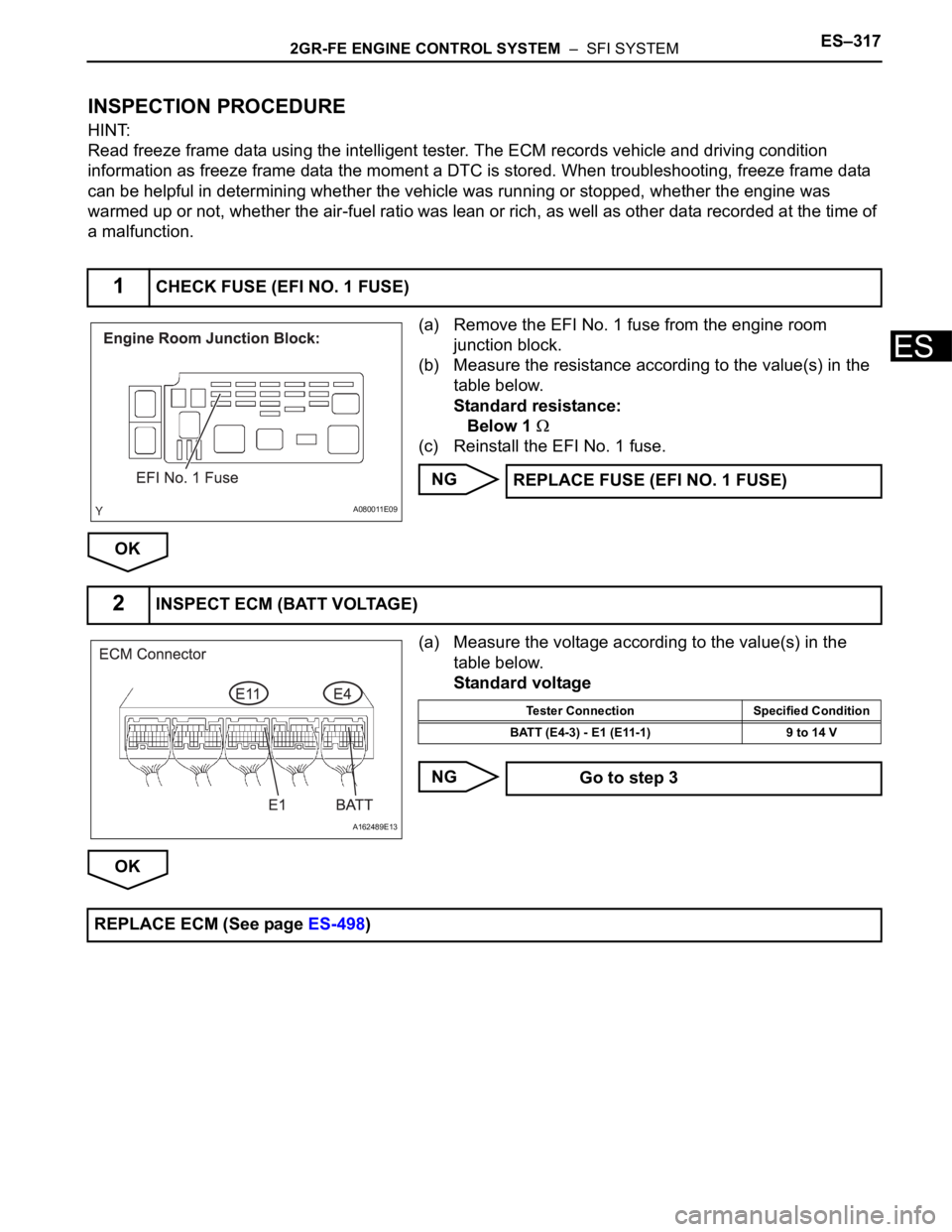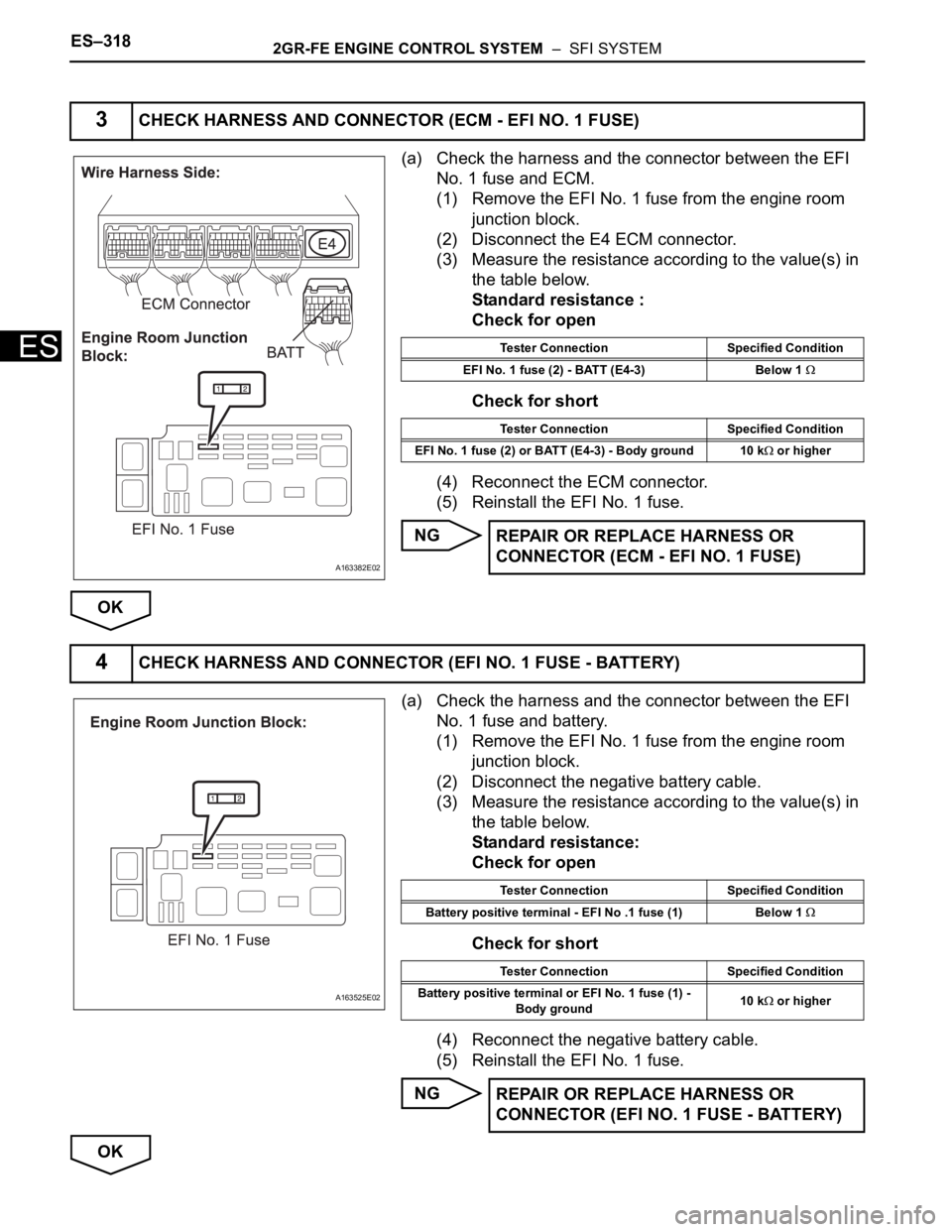Page 607 of 3000
ES–3142GR-FE ENGINE CONTROL SYSTEM – SFI SYSTEM
ES
OK:
Air cleaner filter element is not excessively
contaminated with dirt or oil.
NG
OK
NEXT
NEXT
NEXT
NEXT
NEXT
(a) Check for deposits around the throttle valve and throttle
valve condition.
OK:
No deposits around throttle valve and throttle valve
moves smoothly.
NG
OK
NEXT Go to step 11
7REPLACE MASS AIR FLOW METER
Go to step 15
8CHECK AND REPAIR VVT SENSOR
Go to step 15
9REPAIR OR REPLACE PCV HOSE
Go to step 15
10REPAIR OR REPLACE INTAKE SYSTEM
Go to step 15
11REPLACE AIR CLEANER FILTER ELEMENT SUB-ASSEMBLY
Go to step 15
12CHECK THROTTLE VALVE
Go to step 14
13REPLACE ECM
Go to step 15
Page 608 of 3000
2GR-FE ENGINE CONTROL SYSTEM – SFI SYSTEMES–315
ES
NEXT
NOTICE:
In this operation, the engine must be cold (the same level
as the engine coolant temperature recorded in the freeze
frame data).
(a) Connect the intelligent tester to the DLC3.
(b) Turn the ignition switch to the ON position.
(c) Turn the tester on.
(d) Clear the DTCs.
(e) Switch the ECM from normal mode to check mode using
the tester.
(f) Start the engine to idle for a minute.
OK:
Stable fast idling.
(g) Read the DTCs.
OK:
No DTC output.
NEXT
14REPAIR OR REPLACE THROTTLE BODY ASSEMBLY
Go to step 15
15CHECK WHETHER DTC OUTPUT RECURS (DTC P050B)
END
Page 610 of 3000

2GR-FE ENGINE CONTROL SYSTEM – SFI SYSTEMES–317
ES
INSPECTION PROCEDURE
HINT:
Read freeze frame data using the intelligent tester. The ECM records vehicle and driving condition
information as freeze frame data the moment a DTC is stored. When troubleshooting, freeze frame data
can be helpful in determining whether the vehicle was running or stopped, whether the engine was
warmed up or not, whether the air-fuel ratio was lean or rich, as well as other data recorded at the time of
a malfunction.
(a) Remove the EFI No. 1 fuse from the engine room
junction block.
(b) Measure the resistance according to the value(s) in the
table below.
Standard resistance:
Below 1
(c) Reinstall the EFI No. 1 fuse.
NG
OK
(a) Measure the voltage according to the value(s) in the
table below.
Standard voltage
NG
OK
1CHECK FUSE (EFI NO. 1 FUSE)
A080011E09
REPLACE FUSE (EFI NO. 1 FUSE)
2INSPECT ECM (BATT VOLTAGE)
A162489E13
Tester Connection Specified Condition
BATT (E4-3) - E1 (E11-1) 9 to 14 V
Go to step 3
REPLACE ECM (See page ES-498)
Page 611 of 3000

ES–3182GR-FE ENGINE CONTROL SYSTEM – SFI SYSTEM
ES
(a) Check the harness and the connector between the EFI
No. 1 fuse and ECM.
(1) Remove the EFI No. 1 fuse from the engine room
junction block.
(2) Disconnect the E4 ECM connector.
(3) Measure the resistance according to the value(s) in
the table below.
Standard resistance :
Check for open
Check for short
(4) Reconnect the ECM connector.
(5) Reinstall the EFI No. 1 fuse.
NG
OK
(a) Check the harness and the connector between the EFI
No. 1 fuse and battery.
(1) Remove the EFI No. 1 fuse from the engine room
junction block.
(2) Disconnect the negative battery cable.
(3) Measure the resistance according to the value(s) in
the table below.
Standard resistance:
Check for open
Check for short
(4) Reconnect the negative battery cable.
(5) Reinstall the EFI No. 1 fuse.
NG
OK
3CHECK HARNESS AND CONNECTOR (ECM - EFI NO. 1 FUSE)
A163382E02
Tester Connection Specified Condition
EFI No. 1 fuse (2) - BATT (E4-3) Below 1
Tester Connection Specified Condition
EFI No. 1 fuse (2) or BATT (E4-3) - Body ground 10 k
or higher
REPAIR OR REPLACE HARNESS OR
CONNECTOR (ECM - EFI NO. 1 FUSE)
4CHECK HARNESS AND CONNECTOR (EFI NO. 1 FUSE - BATTERY)
A163525E02
Tester Connection Specified Condition
Battery positive terminal - EFI No .1 fuse (1) Below 1
Tester Connection Specified Condition
Battery positive terminal or EFI No. 1 fuse (1) -
Body ground10 k
or higher
REPAIR OR REPLACE HARNESS OR
CONNECTOR (EFI NO. 1 FUSE - BATTERY)
Page 612 of 3000
2GR-FE ENGINE CONTROL SYSTEM – SFI SYSTEMES–319
ES
(a) Check that the battery is not depleted.
NG
OK
5INSPECT BATTERY
REPLACE BATTERY
CHECK AND REPLACE ENGINE ROOM RELAY BLOCK
Page 613 of 3000

ES–3202GR-FE ENGINE CONTROL SYSTEM – SFI SYSTEM
ES
DESCRIPTION
The ECM continuously monitors its own internal memory status, internal circuits, and output signals
transmitted to the throttle actuator. This self-check ensures that the ECM is functioning properly. If any
malfunction is detected, the ECM sets the appropriate DTC and illuminates the MIL.
The ECM memory status is diagnosed by internal mirroring of the main CPU and the sub CPU to detect
Random Access Memory (RAM) errors. The two CPUs also perform continuous mutual monitoring. The
ECM illuminates the MIL and sets a DTC if: 1) outputs from the two CPUs are different or deviate from the
standards, 2) the signals sent to the throttle actuator deviate from the standards, 3) a malfunction is found
in the throttle actuator supply voltage, and 4) any other ECM malfunction is found.
MONITOR STRATEGY
TYPICAL ENABLING CONDITIONS
TYPICAL MALFUNCTION THRESHOLDS
ECM RAM errors:
INSPECTION PROCEDURE
Read freeze frame data using the intelligent tester. Freeze frame data records the engine condition when
malfunctions are detected. When troubleshooting, freeze frame data can help determine if the vehicle was
moving or stationary, if the engine was warmed up or not, if the air-fuel ratio was lean or rich, and other
data from the time the malfunction occurred.
(a) Connect the intelligent tester to the DLC3.
(b) Turn the ignition switch to the ON position.
(c) Turn the tester on.
(d) Select the following menu items: DIAGNOSIS /
ENHANCED OBD II / DTC INFO / CURRENT CODES.
(e) Read DTCs.
DTC P0604Internal Control Module Random Access Mem-
ory (RAM) Error
DTC No. DTC Detection Condition Trouble Area
P0604 ECM internal error (1 trip detection logic) ECM
Related DTCs P0604: ECM RAM error
Required Sensors/Components (Main) ECM
Required Sensors/Components (Related) -
Frequency of Operation Continuous
Duration 16 seconds
MIL Operation Immediate
Sequence of Operation None
Monitor runs whenever following DTCs not present None
RAM mirror check Fail
1CHECK ANY OTHER DTCS OUTPUT (IN ADDITION TO DTC P0604)
Page 614 of 3000
2GR-FE ENGINE CONTROL SYSTEM – SFI SYSTEMES–321
ES
Result
B
A
Display (DTC Output) Proceed to
P0604 A
No output B
CHECK FOR INTERMITTENT PROBLEMS
REPLACE ECM
Page 615 of 3000

ES–3222GR-FE ENGINE CONTROL SYSTEM – SFI SYSTEM
ES
DESCRIPTION
The ECM continuously monitors its internal processors (CPUs), A/F sensor transistors and heated oxygen
sensor (HO2S) transistors. This self-check ensures that the ECM is functioning properly. These are
diagnosed by internal "mirroring" of the main and sub CPUs to detect the processors error. If outputs from
the processors deviate from the standards, the ECM will illuminate the MIL and set a DTC immediately.
MONITOR STRATEGY
TYPICAL ENABLING CONDITIONS
TYPICAL MALFUNCTION THRESHOLDS
INSPECTION PROCEDURE
(a) Allow the engine to idle.
(b) Check for exhaust gas leak around the heated oxygen
sensor.
OK:
No leak from the heated oxygen sensor.
NG
DTC P0606 ECM / PCM Processor
DTC DTC Setting Condition Trouble Area
P0606• ECM CPUs malfunction
• A/F sensor transistors malfunction
• HO2S transistors malfunction• Exhaust gas leak
•HO2 Sensor
•ECM
Related DTC P0606: ECM range check
Required sensors/Components (main) ECM
Required sensors/Components (sub)APP sensor, TP sensor, Brake switch, Cruise control, A/F sensor,
HO2 sensor
Frequency of Operation Continuous
Duration 60 seconds
MIL Operation Immediate
Sequence of Operation None
Monitor runs whenever the following DTCs are not present None
Engine Running
Estimated A/F sensor temperature 450 to 800
C (842 to 1472F)
Estimated HO2S temperature 450 to 800
C (842 to 1472F)
Difference of main APP and sub APP 0.3 V or more
Difference of main TP and sub TP 0.3 V or more
Difference of main brake switch signal and sub brake switch signal Different
Cruise control Fail
A/F sensor transistors Fail
HO2S transistors Fail
1INSPECT FOR EXHAUST GAS LEAK
REPAIR OR REPLACE EXHAUST GAS
LEAKAGE POINT